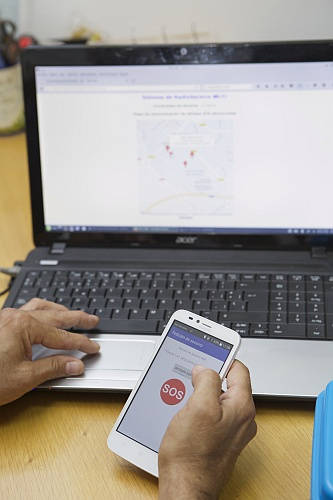| App Locates People Even When There Is No Service |
| Written by Mike James | |||
| Sunday, 31 December 2017 | |||
|
Just when you thought there were no new apps, along comes a good idea. The details are thin, but once you have the idea you can start to invent your own twists on the solution. If you walk, or engage in more adventurous pursuits, in even slightly remote areas then you probably worry about having an accident that leaves you immobile. This is far more common a problem than you might think with increasing numbers of older people taking to walking in the countryside. All you need to do is fall into a ditch and finding you becomes a really difficult task. The obvious answer is to have some sort of radio beacon that makes it possible for the emergency and rescue services to find you. There are already apps that will send an emergency call using a phone connection, but in a more remote locations phone service might be patchy or non-existant. You can buy satelite emergency beacons, but these are expensive enough to be restricted to "serious" climbers and skiers.
Researchers at the Universidad de Alicante, Spain, have developed a new app that uses the WiFi radio inside almost every smartphone to transmit a location signal. José Ángel Berná of the Department of Physics and Systems Engineering has implemented an app that can use the WiFi to transmit a signal that is claimed to reach several kilometers. There isn't much exact information available on how this works, but as a receiver is used to add on to phones used by the rescue services, it is clear that this isn't standard WiFi we are talking about, or if it is the receiver is responsible for the increased range. The receiver is estimated to cost 600 Euros. The radio that is generally used in smartphones is capable of doing more than WiFi - for example it is used to implement Bluetooth as well. However, accessing the low-level hardware is difficult. Using the standard WiFi APIs is also not a solution because sending a WiFi packet assumes that you have first connected to an infrastructure network, i.e. an acess point. This means there is no obvious way to get the radio to broadcast anything unless it is connected to a network and clearly in this instance it needs to broadcast all of the time, network or no-network. So how is it done? The real answer is that I have no idea, but I have spent some time playing with different ways of achieving the result. The only "easy" way I can think of is to use the phone as a hotspot and get it to transmit its SSID every few minutes. The SSID is a 32-byte packet and the location latitude and longitude only need 11 bytes each. The only problem is that there is no standard SDK for working with hotspots and so you would need to make use of one of the third party classes that use introspection to do the job. I don't think that this is how the app works, however, because it needs an additional receiver to pickup the data packet. The SSID approach could probably be implemented as another app by simply scanning for SSID broadcasts. Have you any better suggestion? More InformationAn app locates missing people in environments without mobile phone coverage Related ArticlesTo be informed about new articles on I Programmer, sign up for our weekly newsletter, subscribe to the RSS feed and follow us on Twitter, Facebook or Linkedin.
Comments
or email your comment to: comments@i-programmer.info |
|||
| Last Updated ( Sunday, 31 December 2017 ) |


